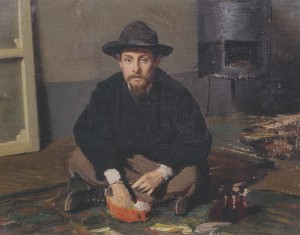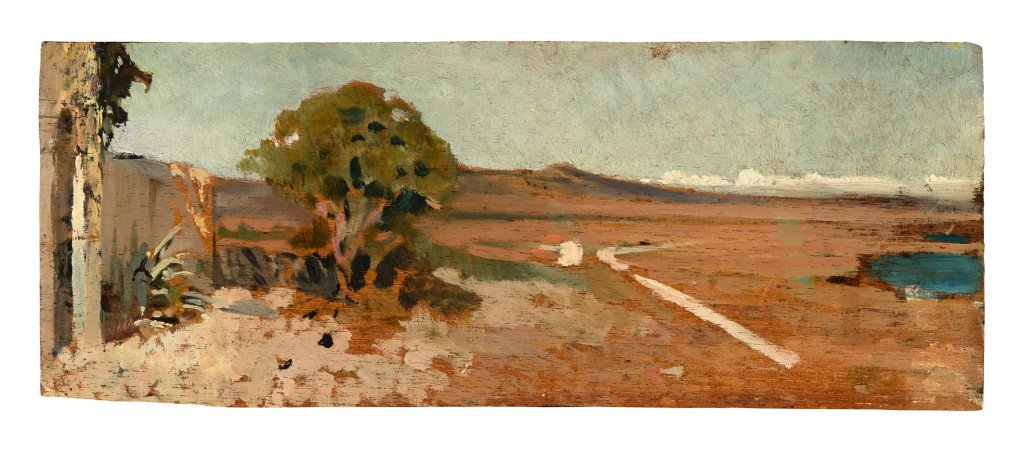Telemaco Signorini (1835 - Florence - 1901)
Castiglioncello, 1861-2
Oil on panel, 11.5 x 29.5 cm
A hand-written evaluation on the verso by Piero Dini reads Il dipinto è opera significativa / databile intorno al 1861-62 e / rappresenta un paesaggio verso Castiglioncello / Piero Dini
Provenance:
Manzoni Galleria d'Arte, Milan, auction sale, 28 November 1969, lot 68
Molino delle Armi Galleria d'Arte, Milan, auction sale, 4 June 1981, lot 75
Galleria Olivares, Milan
Private collection, Milan
Authenticated by Istituto Matteucci, Viareggio (archiving certification number 55715)
The group of young secessionist painters known as the Macchiaioli entered a new phase after the turbulence of their early years, when in 1861 they embarked on the discovery of landscape in the countryside of Tuscany. Their search for subjects was closely associated with the name of Diego Martelli[1] (1839-96) and the large country estate he owned near Castiglioncello, a small coastal town in the Maremma.[2] Martelli’s father had died in August 1861, leaving his son the estate. Martelli invited the Macchiaioli to visit him and the estate soon became something of a haven for them – a secluded setting where they could develop their artistic ideas and work directly from nature. The estate was to be their chief focus in the years that followed – Martelli was even to use the term ‘the School of Castiglioncello’.

Fig. 1 Giovanni Boldini, Portrait of Diego Martelli, c.1865, oil on canvas, 14.8 x 19 cm, Florence, Galleria d’Arte Moderna di Palazzo Pitti
Martelli (Fig. 1) energetically championed the work of the Macchiaioli, becoming their theoretician and sponsor. He was one of the leading art critics of his time and kept in close contact with artists, writers and critics in Paris. He was a close friend of Degas and Zola. In 1867 he founded the journal Il Gazzettino delle Arti del Disegno, the voice of Italian artistic modernism in general and of the Macchiaioli in particular. Signorini was its leading columnist – he wrote twenty-five articles for the journal in the twelve months of its life.[3]
Signorini travelled to Castiglioncello in the company of Martelli, Giuseppe Abbati and Michele Tedesco on 4 August 1861. Signorini describes this first visit in his autobiography. He had recently returned from Paris and was full of fresh ideas. He had seen paintings by François Millet and Jules Breton, and been introduced to the work of Corot and Courbet. He had rounded off the visit to France by familiarizing himself with the whole range of contemporary developments in French painting at the Paris Salon. He was now well prepared to depict the striking scenery and intense light of the Maremma.
This oil study is one of very few extant studies executed by Signorini at Castiglioncello. The landscape is suffused with the warmth of direct summer sunlight. The composition is framed at the left by part of the high wall enclosing Martelli’s property. A mature agave hugs the foot of the wall and at its corner is an ilex. A single stroke of white is used to indicate a track which leads the eye towards a range of hills in the near distance. The rich, slightly iridescent tone of the exposed surface of the panel is allowed to show through, supplying a vibrant compositional element underneath the quick touches and dabs of the brush. These dabs of colour are highly characteristic of the work of the Macchiaioli. The support Signorini has chosen is a panel of thin satinwood veneer, a rare tropical hardwood traditionally used in cabinet-making in the eighteenth and early nineteenth centuries.
[1] See Piero Dini and Francesca Dini, Diego Martelli, l’amico dei Macchiaioli e degli Impressionisti, exhib. cat., Castiglioncello, Galleria comunale d’arte contemporanea - Castello Pasquini, 1996. [2] Eid., I Macchiaioli e la Scuola di Castiglioncello, exhib. cat., Castiglioncello, Galleria comunale d’arte contemporanea - Castello Pasquini, 1990. [3] Martelli also owned a collection of work by the Macchiaioli. He bequeathed it to the City of Florence in 1896. See Toskanische Impressionen. Der Beitrag der Macchiaioli zum europäischen Realismus, exhib. cat., Munich, Bayerische Staatsgemäldesammlungen and Haus der Kunst, Munich 1975, pp. 20-6.

